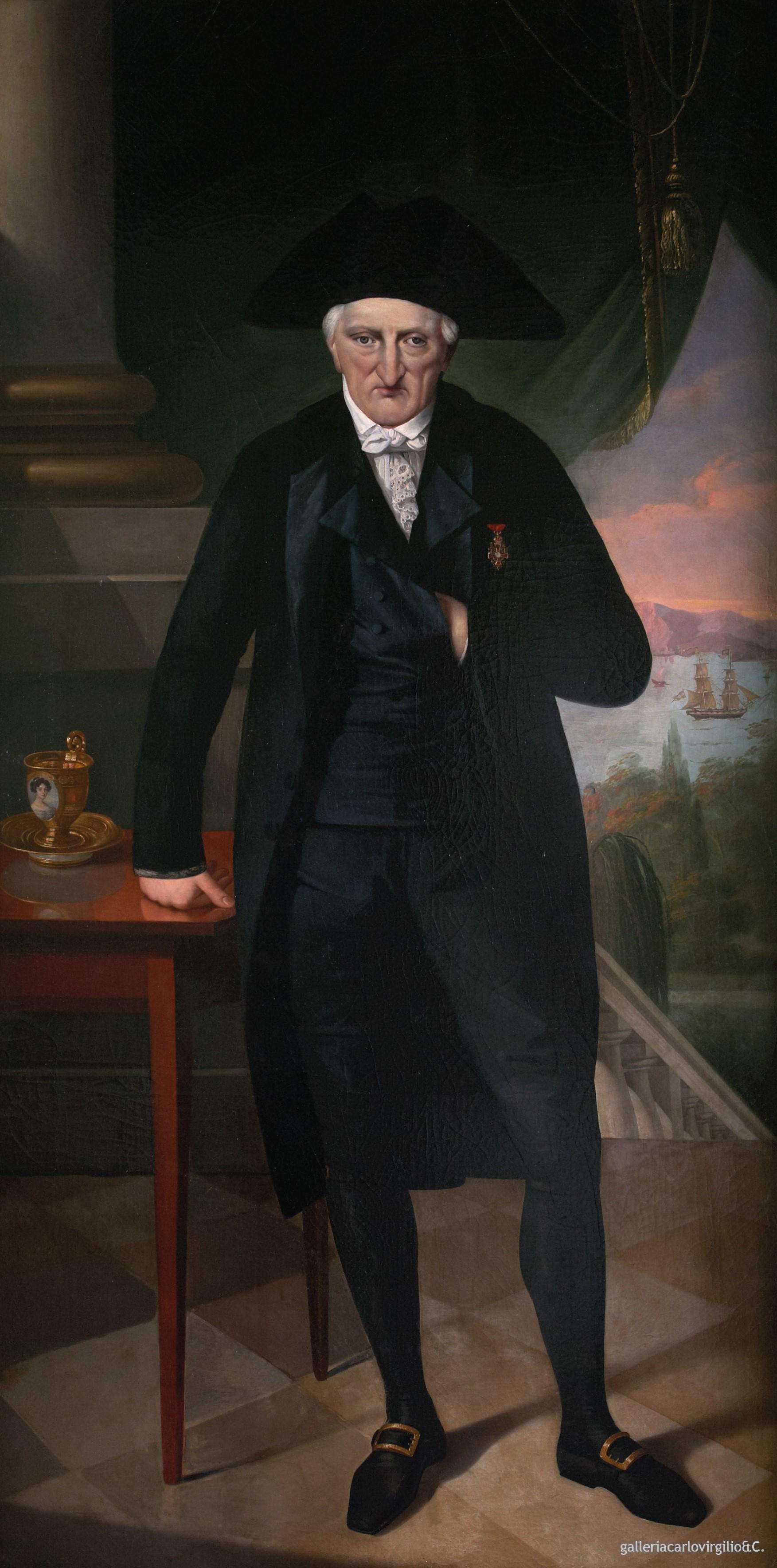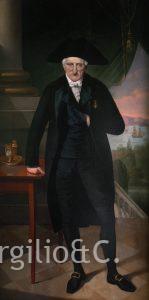| NOT AVAILABLE

Giuseppe Tominz
(Gorizia 1790 – Gradiscutta 1866)
Portrait of Aron Isaak de Parente
after 1847
Oil on canvas, 225 x 112 cm
Active in Trieste from as early as the mid-16th century, the Parente family – like the Morpurgos, the Luzzattos and the della Vidas – were part of a group of Jewish families that successfully controlled the city’s trading sector, consolidating their financial influence through frequent marriage alliances between their respective children. Aron Isaak Parente was born in Trieste on May 21st 1775[1] and married Regina Morpurgo at the age of 21. He died in Trieste on May 12th 1853. Together with his considerable business successes, the various public offices he held eventually earned him the title of baron of the Austrian Empire on December 6th 1847, hence the addition of the “de“ that preceded the name from then onwards.
The Cross of Leopold in red enamel bordered with white stands out on the severe background of the clothes worn by the newly elevated baron, dressed entirely in black from his square buckled shoes to the bicorn hat, worn firmly set over the head in the manner of the 1790s. A very similar portrait confirms the identity of the sitter, painted posthumously and half-length in 1854. Signed by Lipparini, this painting is currently at the Camera di Commercio of Trieste and shows de Parente in almost identical dress.
Both Massimo De Grassi and Alessandro Quinzi, who recently published a monograph on Tominz, agree on the paternity of this large-scale, formal and commemorative portrait, whose austere composition is nonetheless softened by a number of more ‘homely’ Biedermeier details. The surroundings in which Tominz has placed the black-clad figure recall the grand formality of the imperial portraits, almost as if the baron had wished to re-forge his image in the semblance of a tradition to which his title now gave him rightful access. In painting this portrait Tominz, who had already had the opportunity to measure his talents against such commissions with his large portraits – from etchings – of Francis I (1822) and Ferdinand I (1837), appears to have drawn on the canvas by Leopold Kupelweiser (1796-1862) of Emperor Ferdinand I in the Schönbrunn Palace. The painting shows the emperor in 1847, with the same column partially covered by a drape, the balustrade dropping sharply towards the countryside beneath and the black and white, diagonally checkered marble floor that creates the visual effect of propelling the baron towards the viewer. Clearly in Tominz’s work the countryside is the port of Trieste. In the portrait of Francis I the emperor has his hand placed on an imposing, rococo-style console emblazoned with the symbols of his rank, while de Parente is flanked by a small, extremely simple rectangular table – traced by Grassi among Tominz’s drawings – whose polished light wood surface reflects a solitary gilded porcelain cup placed on a saucer, with an oval in which there is a portrait of a young lady.
It is unlikely, as some have speculated, that the young lady in question is Regina Morpurgo, whose youth would have coincided with the neoclassical Empire style whereas both the style of the dress and the design of the cup instead date from around 1840. In any case we do have some idea of what Isaak’s wife really looked like from a miniature in the Civici Musei di Storia ed Arte in Trieste, which was acquired on the antique market as a Portrait of Regina Morpurgo Parente, (circa 1835 inv. 2527). The lady in the oval could conceivably be Stella, who married Isaak’s son Salomon (1808-1873) in 1828 and who therefore embodied the hopes for a continuation in the de Parente baronial dynasty.
An important collector and erudite bibliophile, by 1832 Salomon was already the proud possessor of the exceptional Florilège de Rothschild – a compendium of Hebrew texts illuminated in 1479 by the same artists who had been in the service of Borso d’Este. When the manuscript went up for sale in 1855 the Rothschilds in Paris bought it. After escaping the Holocaust unscathed, the piece was eventually donated to the Bezalel Museum in Jerusalem, where it is to this day. It is by no means inconceivable that such a refined collector could have personally commissioned a cup of this kind, with his wife’s portrait on it. The most likely possibility, however, is that – given his choice of a Habsburg ‘setting’ for his portrait – Isaak had wished to discreetly include an image of his sovereign in the picture: she who had visited Trieste alongside the emperor in 1844, Maria Anna Carolina of Savoy, whose long neck, pointed chin and thin lips appear just discernible amidst the gilt of the porcelain. It was customary at the time for Austrian emperors to circulate their informal effigies also on tasteful object of domestic use such as Viennese porcelain, as is amply documented by the many cups of this kind that still survive. Kaiser Franz and Kaiserin Maria Ludovika, for example, on two gilded cylindrical cups from 1806 (cfr. Folnesics Braun 1907, pp. 140-41), are not wearing full imperial dress but the fashion of the time. Again, Kaiser Franz appears in civilian clothes on two other gilded, trumpet-shaped cups from 1830 (It is worthwhile noting that the shape of the cup, with its thick base and vaulted handle, is more akin to the Biedermeier series produced by KPM (Königliche Porzellan Manufaktur) of Berlin. It was not until Franz’s successor, Franz Joseph and particularly his legendary consort Sissi – the media icon of the finis austriae par excellence –, that the practice became commonplace to the point of pedestrian.
Patrizia Rosazza Ferraris
The Carlo Virgilio & C. Gallery searches for works by Tominz Giuseppe (1790-1866)
To buy or sell works by Tominz Giuseppe (1790-1866) or to request free estimates and evaluations
mail info@carlovirgilio.co.uk
whatsapp +39 3382427650
